FORD ECOSPORT 2022 Warranty Guide
Manufacturer: FORD, Model Year: 2022, Model line: ECOSPORT, Model: FORD ECOSPORT 2022Pages: 73, PDF Size: 3.06 MB
Page 61 of 73
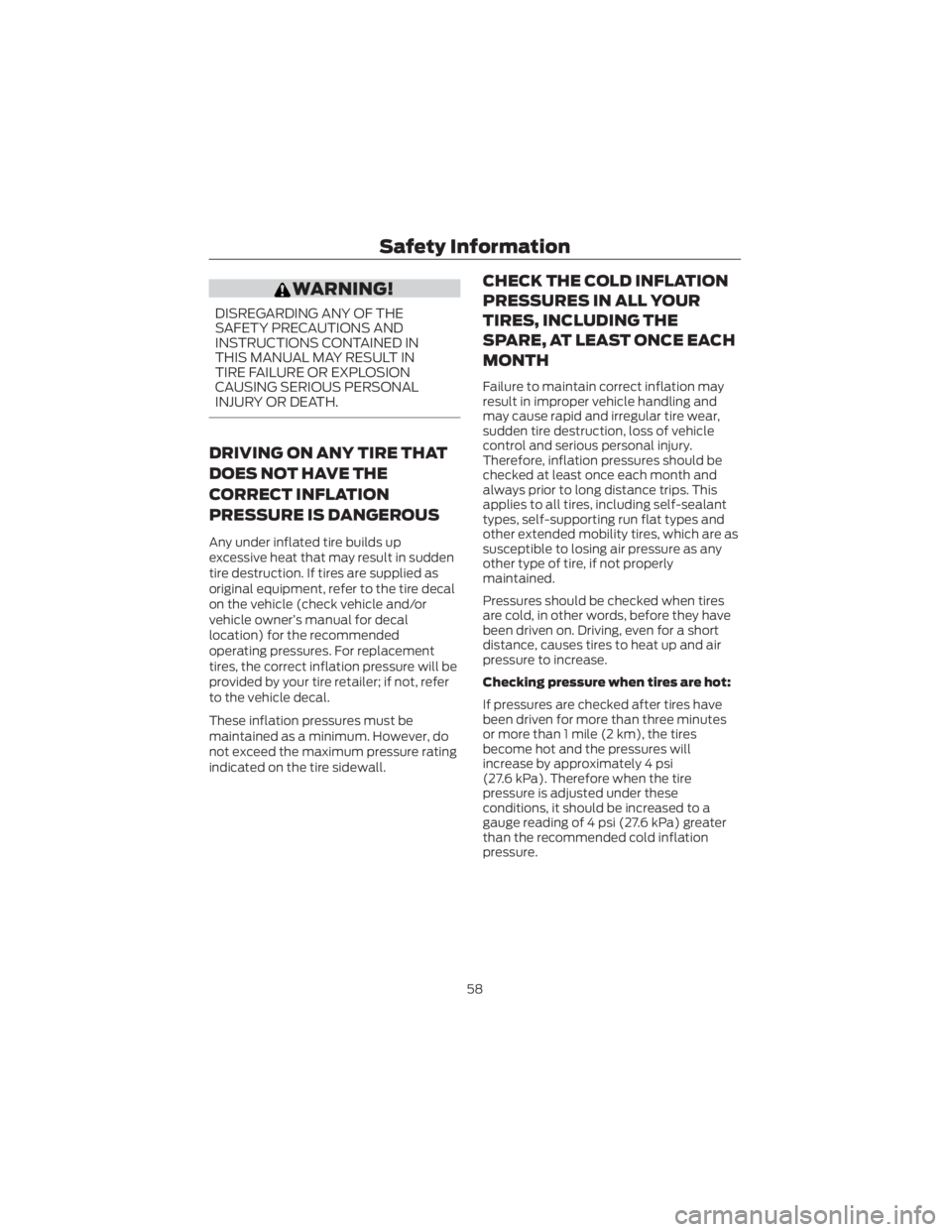
WARNING!
DISREGARDING ANY OF THE
SAFETY PRECAUTIONS AND
INSTRUCTIONS CONTAINED IN
THIS MANUAL MAY RESULT IN
TIRE FAILURE OR EXPLOSION
CAUSING SERIOUS PERSONAL
INJURY OR DEATH.
DRIVING ON ANY TIRE THAT
DOES NOT HAVE THE
CORRECT INFLATION
PRESSURE IS DANGEROUS
Any under inflated tire builds up
excessive heat that may result in sudden
tire destruction. If tires are supplied as
original equipment, refer to the tire decal
on the vehicle (check vehicle and/or
vehicle owner’s manual for decal
location) for the recommended
operating pressures. For replacement
tires, the correct inflation pressure will be
provided by your tire retailer; if not, refer
to the vehicle decal.
These inflation pressures must be
maintained as a minimum. However, do
not exceed the maximum pressure rating
indicated on the tire sidewall.
CHECK THE COLD INFLATION
PRESSURES IN ALL YOUR
TIRES, INCLUDING THE
SPARE, AT LEAST ONCE EACH
MONTH
Failure to maintain correct inflation may
result in improper vehicle handling and
may cause rapid and irregular tire wear,
sudden tire destruction, loss of vehicle
control and serious personal injury.
Therefore, inflation pressures should be
checked at least once each month and
always prior to long distance trips. This
applies to all tires, including self-sealant
types, self-supporting run flat types and
other extended mobility tires, which are as
susceptible to losing air pressure as any
other type of tire, if not properly
maintained.
Pressures should be checked when tires
are cold, in other words, before they have
been driven on. Driving, even for a short
distance, causes tires to heat up and air
pressure to increase.
Checking pressure when tires are hot:
If pressures are checked after tires have
been driven for more than three minutes
or more than 1 mile (2 km), the tires
become hot and the pressures will
increase by approximately 4 psi
(27.6 kPa). Therefore when the tire
pressure is adjusted under these
conditions, it should be increased to a
gauge reading of 4 psi (27.6 kPa) greater
than the recommended cold inflation
pressure.
SafetyInformation
58
Page 62 of 73
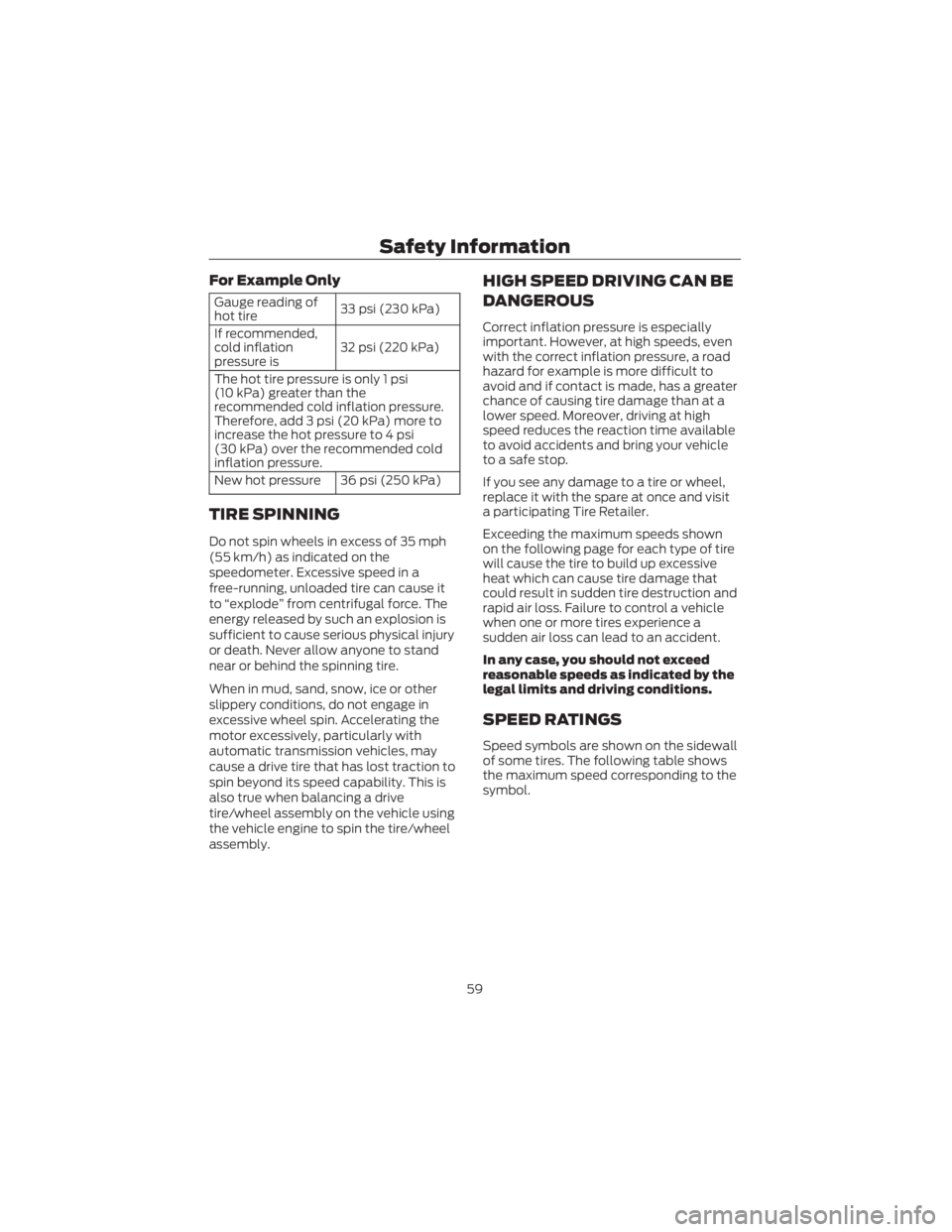
For Example Only
Gauge reading of
hot tire33 psi (230 kPa)
If recommended,
cold inflation
pressure is 32 psi (220 kPa)
The hot tire pressure is only 1 psi
(10 kPa) greater than the
recommended cold inflation pressure.
Therefore, add 3 psi (20 kPa) more to
increase the hot pressure to 4 psi
(30 kPa) over the recommended cold
inflation pressure.
New hot pressure 36 psi (250 kPa)
TIRE SPINNING
Do not spin wheels in excess of 35 mph
(55 km/h) as indicated on the
speedometer. Excessive speed in a
free-running, unloaded tire can cause it
to “explode” from centrifugal force. The
energy released by such an explosion is
sufficient to cause serious physical injury
or death. Never allow anyone to stand
near or behind the spinning tire.
When in mud, sand, snow, ice or other
slippery conditions, do not engage in
excessive wheel spin. Accelerating the
motor excessively, particularly with
automatic transmission vehicles, may
cause a drive tire that has lost traction to
spin beyond its speed capability. This is
also true when balancing a drive
tire/wheel assembly on the vehicle using
the vehicle engine to spin the tire/wheel
assembly.
HIGH SPEED DRIVING CAN BE
DANGEROUS
Correct inflation pressure is especially
important. However, at high speeds, even
with the correct inflation pressure, a road
hazard for example is more difficult to
avoid and if contact is made, has a greater
chance of causing tire damage than at a
lower speed. Moreover, driving at high
speed reduces the reaction time available
to avoid accidents and bring your vehicle
to a safe stop.
If you see any damage to a tire or wheel,
replace it with the spare at once and visit
a participating Tire Retailer.
Exceeding the maximum speeds shown
on the following page for each type of tire
will cause the tire to build up excessive
heat which can cause tire damage that
could result in sudden tire destruction and
rapid air loss. Failure to control a vehicle
when one or more tires experience a
sudden air loss can lead to an accident.
In any case, you should not exceed
reasonable speeds as indicated by the
legal limits and driving conditions.
SPEED RATINGS
Speed symbols are shown on the sidewall
of some tires. The following table shows
the maximum speed corresponding to the
symbol.
Safety Information
59
Page 63 of 73
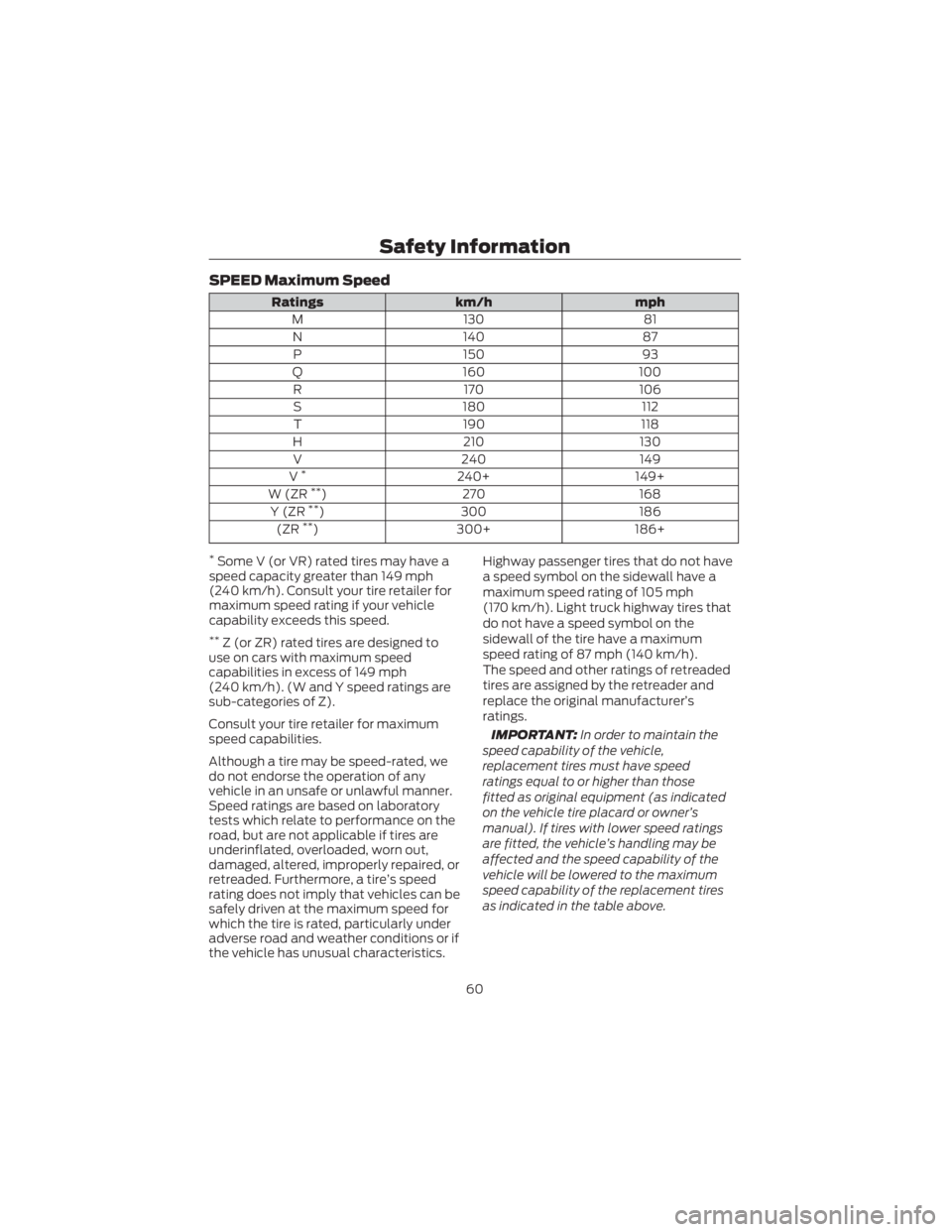
SPEED Maximum Speed
Ratingskm/hmph
M 130 81
N1 408 7
P 150 93
Q 160 100
R 170 106
S 180 112
T 190 118
H 210 130
V 240 149
V
*240+ 149+
W (ZR**) 270 168
Y (ZR**) 300 186
(ZR**) 300+ 186+
*Some V (or VR) rated tires may have a
speed capacity greater than 149 mph
(240 km/h). Consult your tire retailer for
maximum speed rating if your vehicle
capability exceeds this speed.
**Z (or ZR) rated tires are designed to
use on cars with maximum speed
capabilities in excess of 149 mph
(240 km/h). (W and Y speed ratings are
sub-categories of Z).
Consult your tire retailer for maximum
speed capabilities.
Although a tire may be speed-rated, we
do not endorse the operation of any
vehicle in an unsafe or unlawful manner.
Speed ratings are based on laboratory
tests which relate to performance on the
road, but are not applicable if tires are
underinflated, overloaded, worn out,
damaged, altered, improperly repaired, or
retreaded. Furthermore, a tire’s speed
rating does not imply that vehicles can be
safely driven at the maximum speed for
which the tire is rated, particularly under
adverse road and weather conditions or if
the vehicle has unusual characteristics. Highway passenger tires that do not have
a speed symbol on the sidewall have a
maximum speed rating of 105 mph
(170 km/h). Light truck highway tires that
do not have a speed symbol on the
sidewall of the tire have a maximum
speed rating of 87 mph (140 km/h).
The speed and other ratings of retreaded
tires are assigned by the retreader and
replace the original manufacturer’s
ratings.
IMPORTANT: In order to maintain the
speed capability of the vehicle,
replacement tires must have speed
ratings equal to or higher than those
fitted as original equipment (as indicated
on the vehicle tire placard or owner’s
manual). If tires with lower speed ratings
are fitted, the vehicle’s handling may be
affected and the speed capability of the
vehicle will be lowered to the maximum
speed capability of the replacement tires
as indicated in the table above.
Safety Information
60
Page 64 of 73
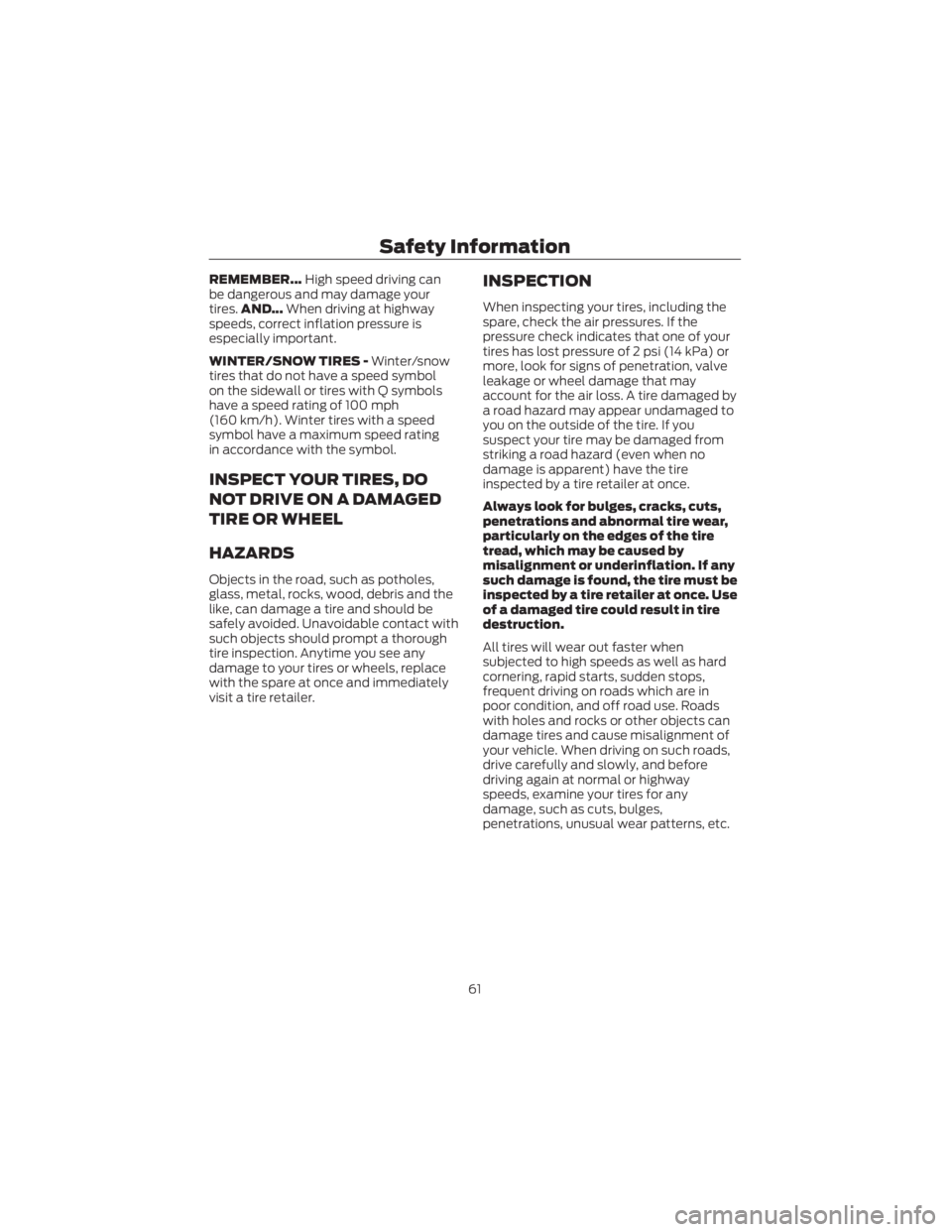
REMEMBER...High speed driving can
be dangerous and may damage your
tires. AND... When driving at highway
speeds, correct inflation pressure is
especially important.
WINTER/SNOW TIRES - Winter/snow
tires that do not have a speed symbol
on the sidewall or tires with Q symbols
have a speed rating of 100 mph
(160 km/h). Winter tires with a speed
symbol have a maximum speed rating
in accordance with the symbol.
INSPECT YOUR TIRES, DO
NOT DRIVE ON A DAMAGED
TIRE OR WHEEL
HAZARDS
Objects in the road, such as potholes,
glass, metal, rocks, wood, debris and the
like, can damage a tire and should be
safely avoided. Unavoidable contact with
such objects should prompt a thorough
tire inspection. Anytime you see any
damage to your tires or wheels, replace
with the spare at once and immediately
visit a tire retailer.
INSPECTION
When inspecting your tires, including the
spare, check the air pressures. If the
pressure check indicates that one of your
tires has lost pressure of 2 psi (14 kPa) or
more, look for signs of penetration, valve
leakage or wheel damage that may
account for the air loss. A tire damaged by
a road hazard may appear undamaged to
you on the outside of the tire. If you
suspect your tire may be damaged from
striking a road hazard (even when no
damage is apparent) have the tire
inspected by a tire retailer at once.
Always look for bulges, cracks, cuts,
penetrations and abnormal tire wear,
particularly on the edges of the tire
tread, which may be caused by
misalignment or underinflation. If any
such damage is found, the tire must be
inspected by a tire retailer at once. Use
of a damaged tire could result in tire
destruction.
All tires will wear out faster when
subjected to high speeds as well as hard
cornering, rapid starts, sudden stops,
frequent driving on roads which are in
poor condition, and off road use. Roads
with holes and rocks or other objects can
damage tires and cause misalignment of
your vehicle. When driving on such roads,
drive carefully and slowly, and before
driving again at normal or highway
speeds, examine your tires for any
damage, such as cuts, bulges,
penetrations, unusual wear patterns, etc.
Safety Information
61
Page 65 of 73
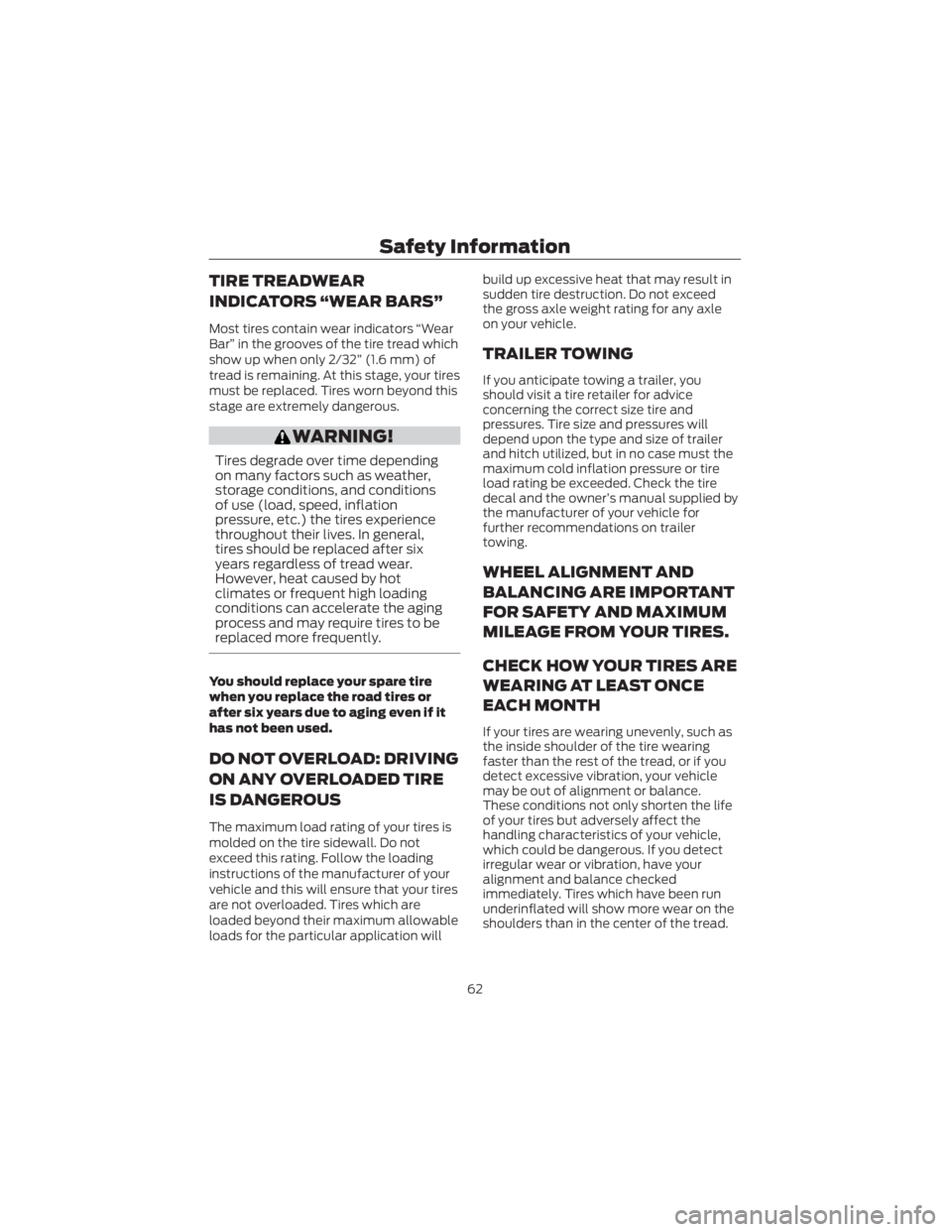
TIRE TREADWEAR
INDICATORS “WEAR BARS”
Most tires contain wear indicators “Wear
Bar” in the grooves of the tire tread which
show up when only 2/32” (1.6 mm) of
tread is remaining. At this stage, your tires
must be replaced. Tires worn beyond this
stage are extremely dangerous.
WARNING!
Tires degrade over time depending
on many factors such as weather,
storage conditions, and conditions
of use (load, speed, inflation
pressure, etc.) the tires experience
throughout their lives. In general,
tires should be replaced after six
years regardless of tread wear.
However, heat caused by hot
climates or frequent high loading
conditions can accelerate the aging
process and may require tires to be
replaced more frequently.
You should replace your spare tire
when you replace the road tires or
after six years due to aging even if it
has not been used.
DO NOT OVERLOAD: DRIVING
ON ANY OVERLOADED TIRE
IS DANGEROUS
The maximum load rating of your tires is
molded on the tire sidewall. Do not
exceed this rating. Follow the loading
instructions of the manufacturer of your
vehicle and this will ensure that your tires
are not overloaded. Tires which are
loaded beyond their maximum allowable
loads for the particular application willbuild up excessive heat that may result in
sudden tire destruction. Do not exceed
the gross axle weight rating for any axle
on your vehicle.
TRAILER TOWING
If you anticipate towing a trailer, you
should visit a tire retailer for advice
concerning the correct size tire and
pressures. Tire size and pressures will
depend upon the type and size of trailer
and hitch utilized, but in no case must the
maximum cold inflation pressure or tire
load rating be exceeded. Check the tire
decal and the owner’s manual supplied by
the manufacturer of your vehicle for
further recommendations on trailer
towing.
WHEEL ALIGNMENT AND
BALANCING ARE IMPORTANT
FOR SAFETY AND MAXIMUM
MILEAGE FROM YOUR TIRES.
CHECK HOW YOUR TIRES ARE
WEARING AT LEAST ONCE
EACH MONTH
If your tires are wearing unevenly, such as
the inside shoulder of the tire wearing
faster than the rest of the tread, or if you
detect excessive vibration, your vehicle
may be out of alignment or balance.
These conditions not only shorten the life
of your tires but adversely affect the
handling characteristics of your vehicle,
which could be dangerous. If you detect
irregular wear or vibration, have your
alignment and balance checked
immediately. Tires which have been run
underinflated will show more wear on the
shoulders than in the center of the tread.
Safety
Information
62
Page 66 of 73
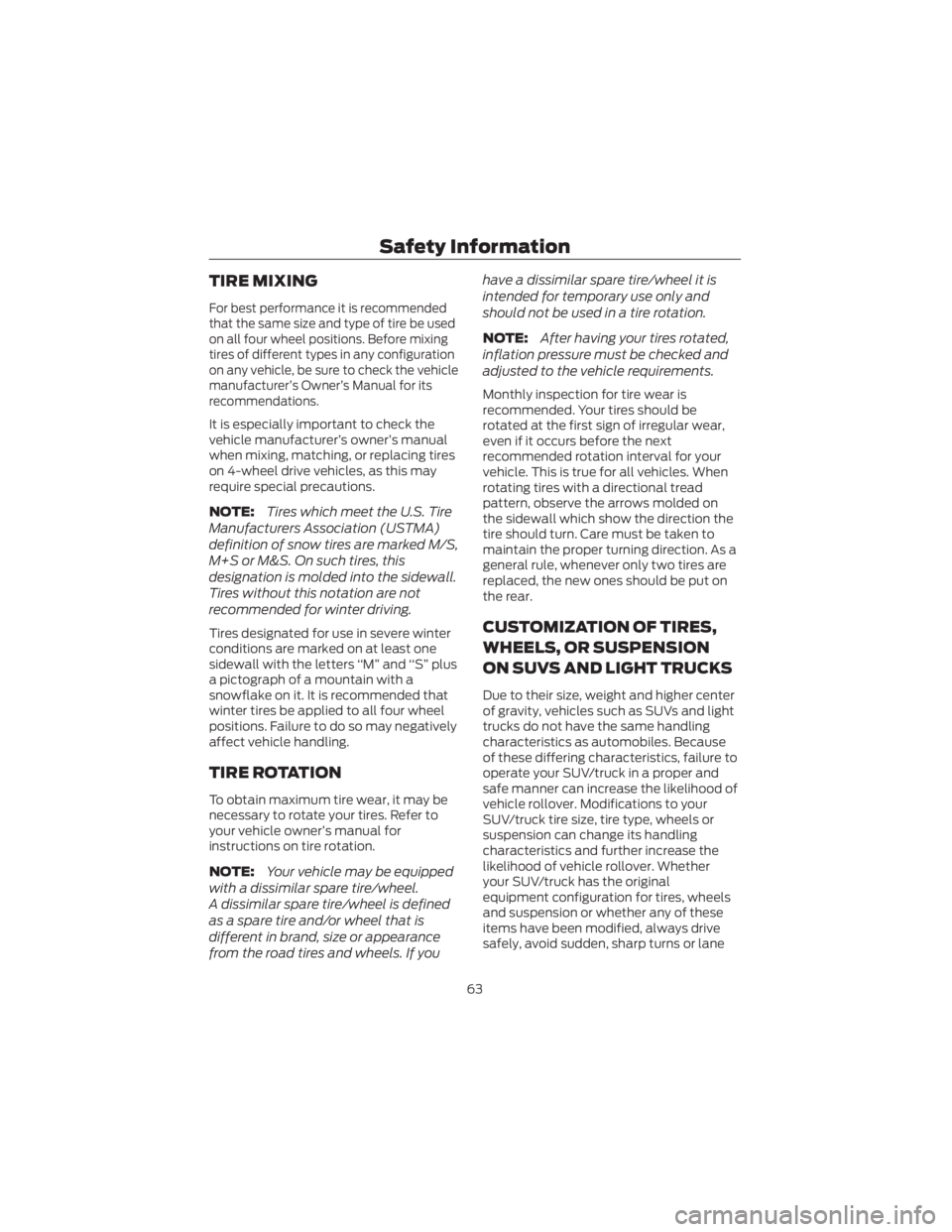
TIRE MIXING
For best performance it is recommended
that the same size and type of tire be used
on all four wheel positions. Before mixing
tires of different types in any configuration
on any vehicle, be sure to check the vehicle
manufacturer’s Owner’s Manual for its
recommendations.
It is especially important to check the
vehicle manufacturer’s owner’s manual
when mixing, matching, or replacing tires
on 4-wheel drive vehicles, as this may
require special precautions.
NOTE:Tires which meet the U.S. Tire
Manufacturers Association (USTMA)
definition of snow tires are marked M/S,
M+S or M&S. On such tires, this
designation is molded into the sidewall.
Tires without this notation are not
recommended for winter driving.
Tires designated for use in severe winter
conditions are marked on at least one
sidewall with the letters ‘‘M” and ‘‘S” plus
a pictograph of a mountain with a
snowflake on it. It is recommended that
winter tires be applied to all four wheel
positions. Failure to do so may negatively
affect vehicle handling.
TIRE ROTATION
To obtain maximum tire wear, it may be
necessary to rotate your tires. Refer to
your vehicle owner’s manual for
instructions on tire rotation.
NOTE: Your vehicle may be equipped
with a dissimilar spare tire/wheel.
A dissimilar spare tire/wheel is defined
as a spare tire and/or wheel that is
different in brand, size or appearance
from the road tires and wheels. If you have a dissimilar spare tire/wheel it is
intended for temporary use only and
should not be used in a tire rotation.
NOTE:
After having your tires rotated,
inflation pressure must be checked and
adjusted to the vehicle requirements.
Monthly inspection for tire wear is
recommended. Your tires should be
rotated at the first sign of irregular wear,
even if it occurs before the next
recommended rotation interval for your
vehicle. This is true for all vehicles. When
rotating tires with a directional tread
pattern, observe the arrows molded on
the sidewall which show the direction the
tire should turn. Care must be taken to
maintain the proper turning direction. As a
general rule, whenever only two tires are
replaced, the new ones should be put on
the rear.
CUSTOMIZATION OF TIRES,
WHEELS, OR SUSPENSION
ON SUVS AND LIGHT TRUCKS
Due to their size, weight and higher center
of gravity, vehicles such as SUVs and light
trucks do not have the same handling
characteristics as automobiles. Because
of these differing characteristics, failure to
operate your SUV/truck in a proper and
safe manner can increase the likelihood of
vehicle rollover. Modifications to your
SUV/truck tire size, tire type, wheels or
suspension can change its handling
characteristics and further increase the
likelihood of vehicle rollover. Whether
your SUV/truck has the original
equipment configuration for tires, wheels
and suspension or whether any of these
items have been modified, always drive
safely, avoid sudden, sharp turns or lane
Safety Information
63
Page 67 of 73
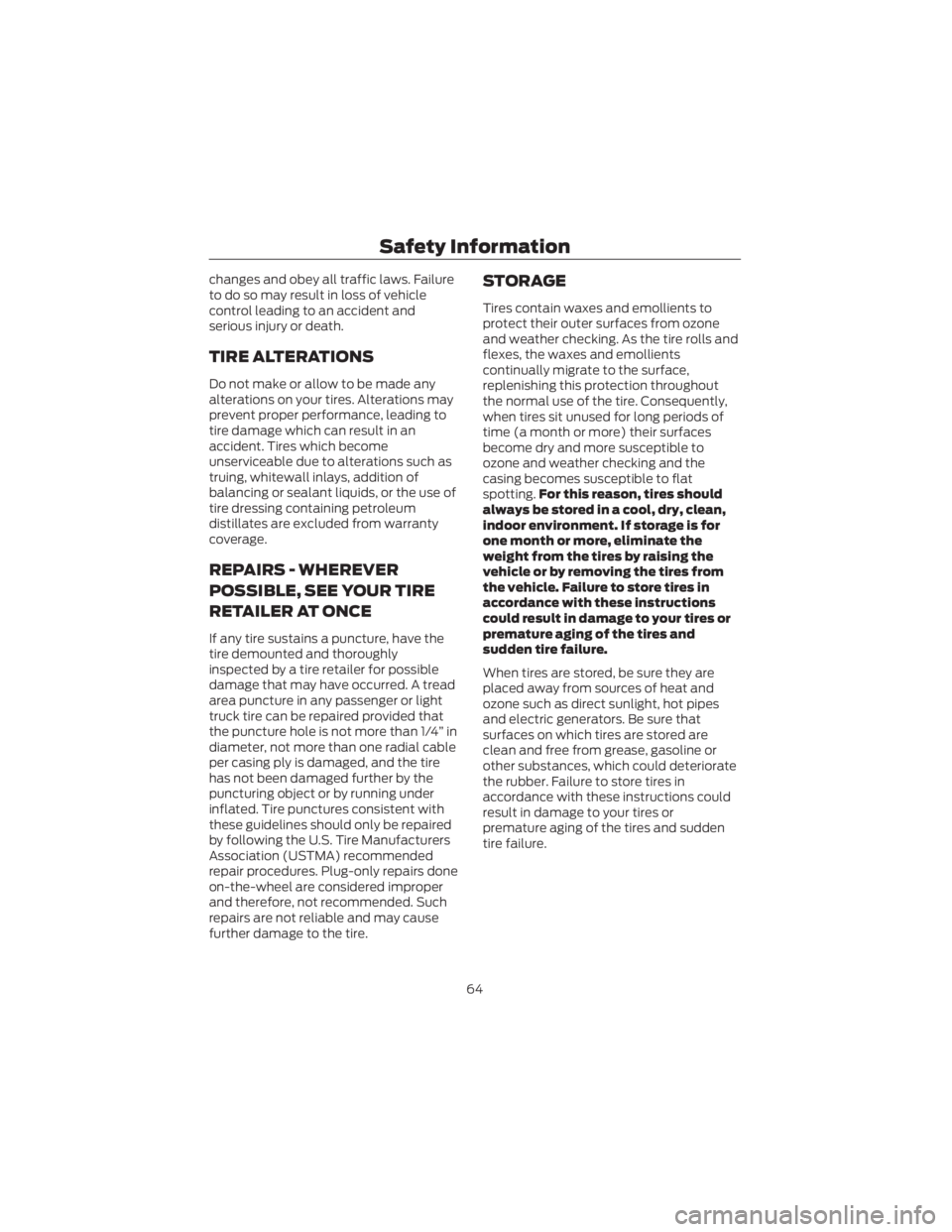
changes and obey all traffic laws. Failure
to do so may result in loss of vehicle
control leading to an accident and
serious injury or death.
TIRE ALTERATIONS
Do not make or allow to be made any
alterations on your tires. Alterations may
prevent proper performance, leading to
tire damage which can result in an
accident. Tires which become
unserviceable due to alterations such as
truing, whitewall inlays, addition of
balancing or sealant liquids, or the use of
tire dressing containing petroleum
distillates are excluded from warranty
coverage.
REPAIRS - WHEREVER
POSSIBLE, SEE YOUR TIRE
RETAILER AT ONCE
If any tire sustains a puncture, have the
tire demounted and thoroughly
inspected by a tire retailer for possible
damage that may have occurred. A tread
area puncture in any passenger or light
truck tire can be repaired provided that
the puncture hole is not more than 1/4” in
diameter, not more than one radial cable
per casing ply is damaged, and the tire
has not been damaged further by the
puncturing object or by running under
inflated. Tire punctures consistent with
these guidelines should only be repaired
by following the U.S. Tire Manufacturers
Association (USTMA) recommended
repair procedures. Plug-only repairs done
on-the-wheel are considered improper
and therefore, not recommended. Such
repairs are not reliable and may cause
further damage to the tire.
STORAGE
Tires contain waxes and emollients to
protect their outer surfaces from ozone
and weather checking. As the tire rolls and
flexes, the waxes and emollients
continually migrate to the surface,
replenishing this protection throughout
the normal use of the tire. Consequently,
when tires sit unused for long periods of
time (a month or more) their surfaces
become dry and more susceptible to
ozone and weather checking and the
casing becomes susceptible to flat
spotting.For this reason, tires should
always be stored in a cool, dry, clean,
indoor environment. If storage is for
one month or more, eliminate the
weight from the tires by raising the
vehicle or by removing the tires from
the vehicle. Failure to store tires in
accordance with these instructions
could result in damage to your tires or
premature aging of the tires and
sudden tire failure.
When tires are stored, be sure they are
placed away from sources of heat and
ozone such as direct sunlight, hot pipes
and electric generators. Be sure that
surfaces on which tires are stored are
clean and free from grease, gasoline or
other substances, which could deteriorate
the rubber. Failure to store tires in
accordance with these instructions could
result in damage to your tires or
premature aging of the tires and sudden
tire failure.
Safety Information
64
Page 68 of 73
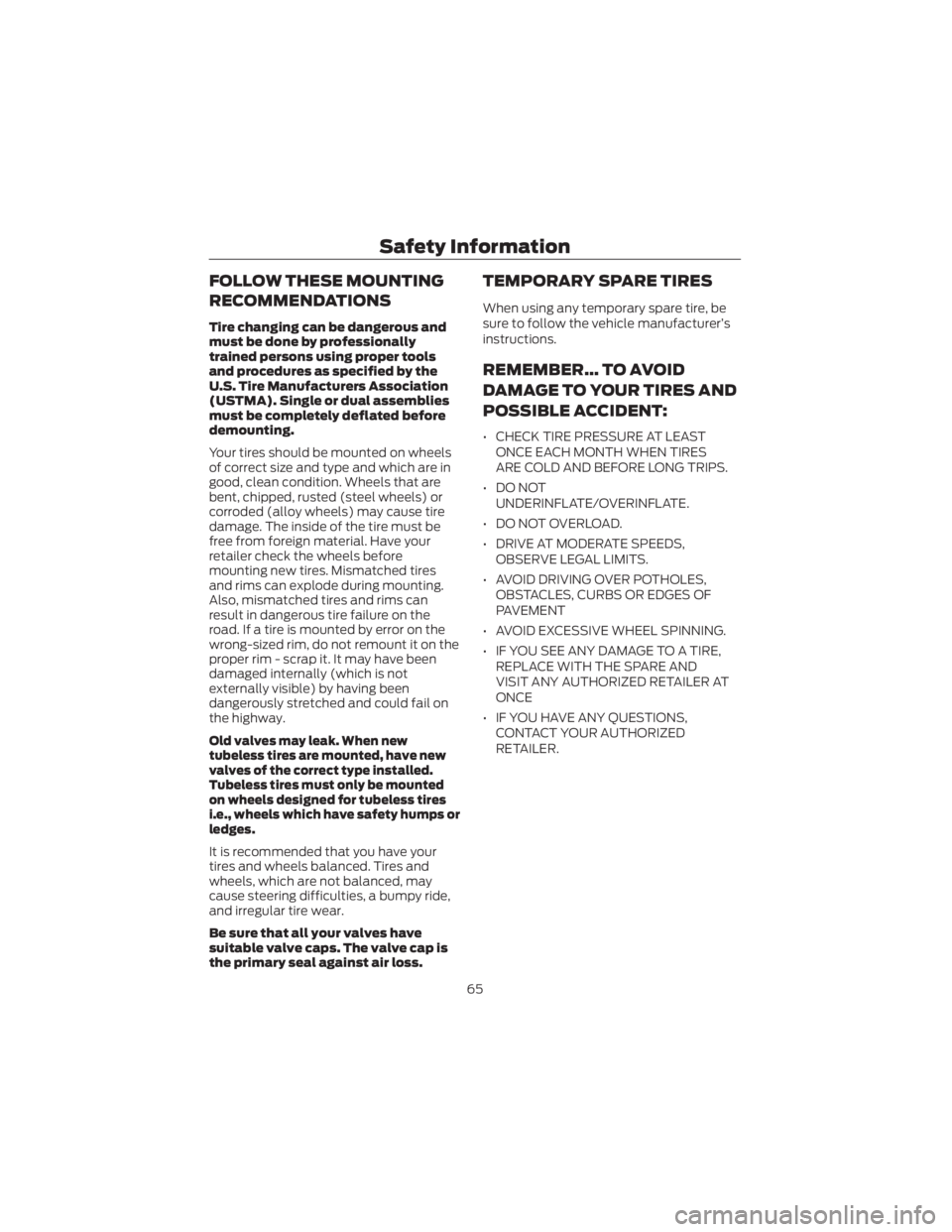
FOLLOW THESE MOUNTING
RECOMMENDATIONS
Tire changing can be dangerous and
must be done by professionally
trained persons using proper tools
and procedures as specified by the
U.S. Tire Manufacturers Association
(USTMA). Single or dual assemblies
must be completely deflated before
demounting.
Your tires should be mounted on wheels
of correct size and type and which are in
good, clean condition. Wheels that are
bent, chipped, rusted (steel wheels) or
corroded (alloy wheels) may cause tire
damage. The inside of the tire must be
free from foreign material. Have your
retailer check the wheels before
mounting new tires. Mismatched tires
and rims can explode during mounting.
Also, mismatched tires and rims can
result in dangerous tire failure on the
road. If a tire is mounted by error on the
wrong-sized rim, do not remount it on the
proper rim - scrap it. It may have been
damaged internally (which is not
externally visible) by having been
dangerously stretched and could fail on
the highway.
Old valves may leak. When new
tubeless tires are mounted, have new
valves of the correct type installed.
Tubeless tires must only be mounted
on wheels designed for tubeless tires
i.e., wheels whichhave safetyhumps or
ledges.
It is recommended that you have your
tires and wheels balanced. Tires and
wheels, which are not balanced, may
cause steering difficulties, a bumpy ride,
and irregular tire wear.
Be sure that all your valves have
suitable valve caps. The valve cap is
the primary seal against air loss.
TEMPORARY SPARE TIRES
When using any temporary spare tire, be
sure to follow the vehicle manufacturer’s
instructions.
REMEMBER... TO AVOID
DAMAGE TO YOUR TIRES AND
POSSIBLE ACCIDENT:
• CHECK TIRE PRESSURE AT LEAST
ONCE EACH MONTH WHEN TIRES
ARE COLD AND BEFORE LONG TRIPS.
•DONOT UNDERINFLATE/OVERINFLATE.
• DO NOT OVERLOAD.
• DRIVE AT MODERATE SPEEDS, OBSERVE LEGAL LIMITS.
• AVOID DRIVING OVER POTHOLES, OBSTACLES, CURBS OR EDGES OF
PAVEMENT
• AVOID EXCESSIVE WHEEL SPINNING.
• IF YOU SEE ANY DAMAGE TO A TIRE, REPLACE WITH THE SPARE AND
VISIT ANY AUTHORIZED RETAILER AT
ONCE
• IF YOU HAVE ANY QUESTIONS, CONTACT YOUR AUTHORIZED
RETAILER.
Safety Information
65
Page 69 of 73
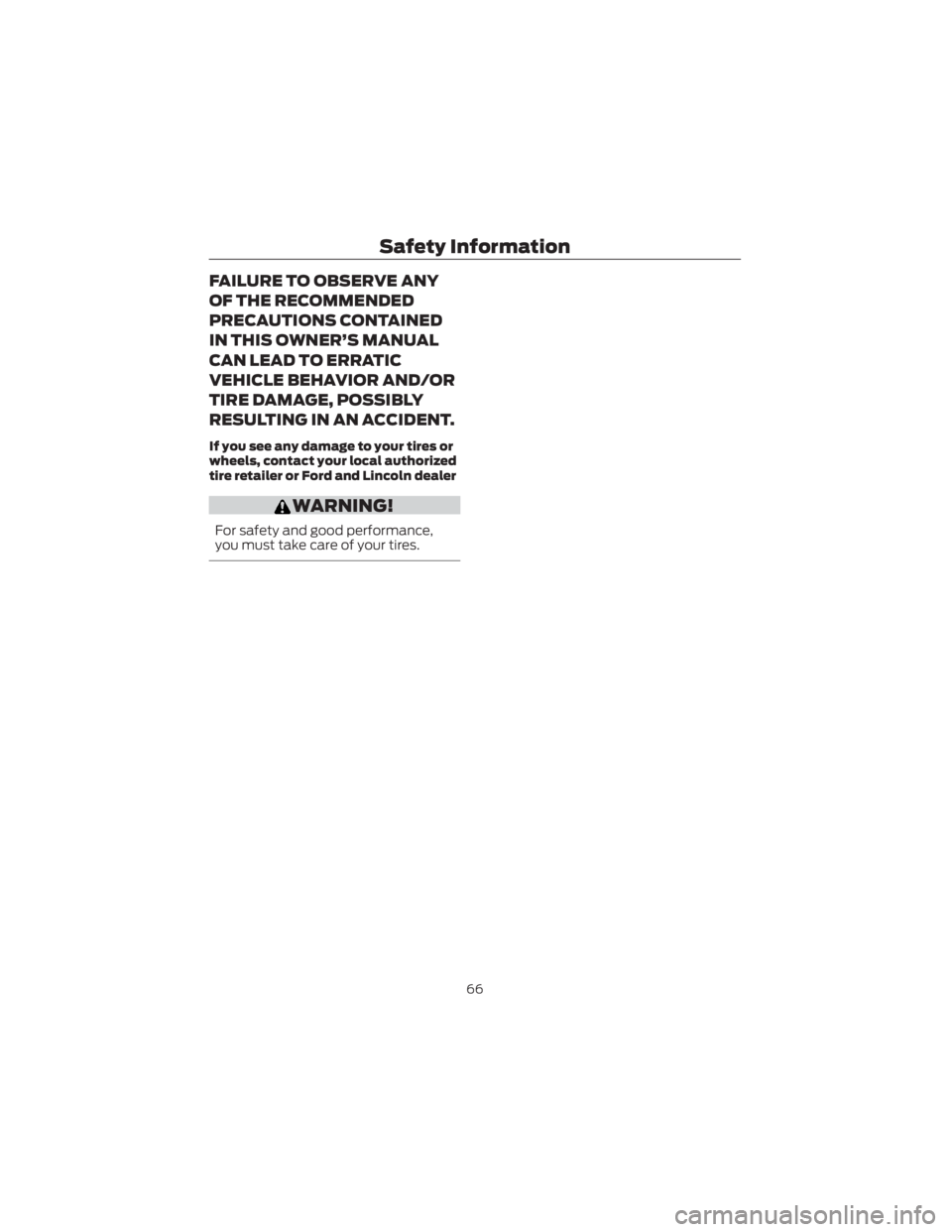
FAILURE TO OBSERVE ANY
OF THE RECOMMENDED
PRECAUTIONS CONTAINED
IN THIS OWNER’S MANUAL
CAN LEAD TO ERRATIC
VEHICLE BEHAVIOR AND/OR
TIRE DAMAGE, POSSIBLY
RESULTING IN AN ACCIDENT.
If you see any damage to your tires or
wheels, contact your local authorized
tire retailer or Ford and Lincoln dealer
WARNING!
For safety and good performance,
you must take care of your tires.
SafetyInformation
66
Page 70 of 73
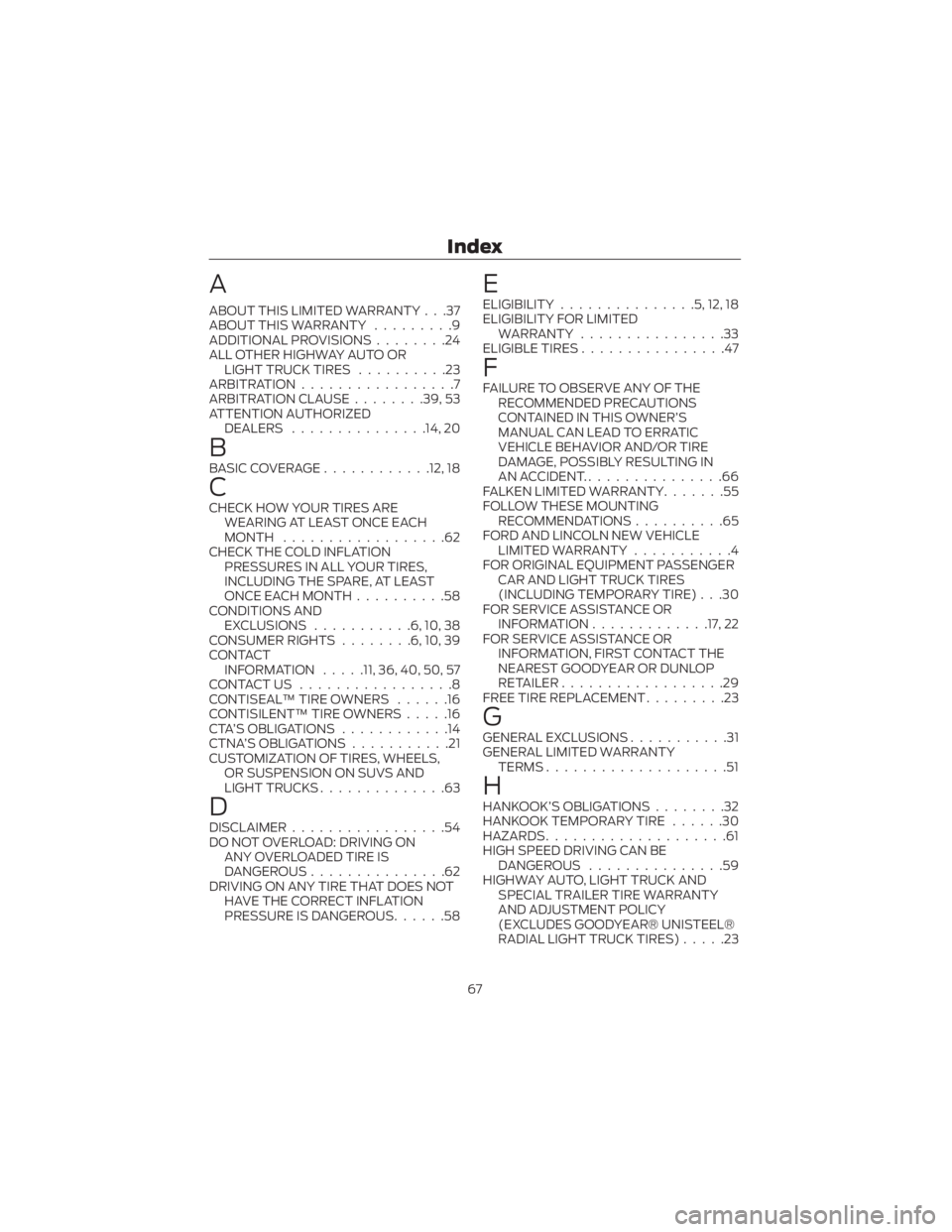
A
ABOUT THIS LIMITED WARRANTY . . .37
ABOUT THIS WARRANTY.........9
ADDITIONAL PROVISIONS ........24
ALL OTHER HIGHWAY AUTO OR LIGHT TRUCK TIRES ..........23
ARBITRATION .................7
ARBITRATION CLAUSE ........39,53
ATTENTION AUTHORIZED DEALERS ...............14,20
B
BASICCOVERAGE............12, 18
C
CHECK HOW YOUR TIRES ARE
WEARING AT LEAST ONCE EACH
MONTH ..................62
CHECK THE COLD INFLATION PRESSURES IN ALL YOUR TIRES,
INCLUDING THE SPARE, AT LEAST
ONCE EACH MONTH ..........58
CONDITIONS AND EXCLUSIONS ...........6,10,38
CONSUMER RIGHTS ........6,10,39
CONTACT INFORMATION .....11, 36, 40, 50, 57
CONTACTUS .................8
CONTISEAL™ TIRE OWNERS ......16
CONTISILENT™ TIRE OWNERS .....16
CTA’S OBLIGATIONS ............14
CTNA’S OBLIGATIONS ...........21
CUSTOMIZATION OF TIRES, WHEELS, OR SUSPENSION ON SUVS AND
LIGHT TRUCKS ..............63
D
DISCLAIMER.................54
DO NOT OVERLOAD: DRIVING ON ANY OVERLOADED TIRE IS
DANGEROUS ...............62
DRIVING ON ANY TIRE THAT DOES NOT HAVE THE CORRECT INFLATION
PRESSURE IS DANGEROUS ......58
E
ELIGIBILITY...............5,12,18
ELIGIBILITY FOR LIMITED WARRANTY ................33
ELIGIBLE TIRES ................47
F
FAILURE TO OBSERVE ANY OF THE
RECOMMENDED PRECAUTIONS
CONTAINED IN THIS OWNER’S
MANUAL CAN LEAD TO ERRATIC
VEHICLE BEHAVIOR AND/OR TIRE
DAMAGE, POSSIBLY RESULTING IN
AN ACCIDENT. ...............66
FALKEN LIMITED WARRANTY .......55
FOLLOW THESE MOUNTING RECOMMENDATIONS ..........65
FORD AND LINCOLN NEW VEHICLE LIMITED WARRANTY ...........4
FOR ORIGINAL EQUIPMENT PASSENGER CAR AND LIGHT TRUCK TIRES
(INCLUDING TEMPORARY TIRE) . . .30
FOR SERVICE ASSISTANCE OR INFORMATION .............17,22
FOR SERVICE ASSISTANCE OR INFORMATION, FIRST CONTACT THE
NEAREST GOODYEAR OR DUNLOP
RETAILER ..................29
FREE TIRE REPLACEMENT .........23
G
GENERAL EXCLUSIONS...........31
GENERAL LIMITED WARRANTY TERMS ....................51
H
HANKOOK’S OBLIGATIONS ........32
HANKOOK TEMPORARY TIRE ......30
HAZARDS....................61
HIGH SPEED DRIVING CAN BE DANGEROUS ...............59
HIGHWAY AUTO, LIGHT TRUCK AND SPECIAL TRAILER TIRE WARRANTY
AND ADJUSTMENT POLICY
(EXCLUDES GOODYEAR® UNISTEEL®
RADIAL LIGHT TRUCK TIRES) .....23
Index
67